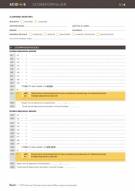

Interview questions are provided conveniently along each corresponding DSM-5 criterion, which aids in rating each as either present or absent.ĭownload The Structured Clinical Interview for DSM-5 Personality Disorders (SCID-5-PD) is a semistructured diagnostic interview for clinicians and researchers to assess the 10 DSM-5 Personality Disorders across Clusters A, B, and C as well as Other Specified Personality Disorder. The Structured Clinical Interview for DSM-5® - Clinician Version (SCID-5-CV) guides the clinician step-by-step through the DSM-5 diagnostic process.
#Scid 5 pd pdf update#
Structured Clinical Interview for DSM-5 Personality Disorders (SCID-5-PD) This official clinical interview of the American Psychiatric Association (APA) is an update of the Structured Clinical Interview for DSM-IV Axis II Personality Disorders (SCID-II) but is very similar. Structured questions follow directly from the DSM-5 and correspond to symptoms for Structured diagnostic interviews such as the Structured Clinical Interview for DSM-IV (SCID-II First, et al., 1997a) involve asking patients or research participants direct questions about specific diagnostic criteria while relying primarily on the examinee’s explicit endorsement of each diagnostic criterion. The Structured Clinical Interview for DSM-5(R) Personality Disorders (SCID-5-PD) is a semistructured diagnostic interview for clinicians and researchers to assess the 10 DSM-5 Personality Disorders across Clusters A, B, and C as well as Other Specified Personality Disorder. The SCID-5-PD is the updated version of the former Structured Clinical Interview for DSM-IV Axis II Personality Disorders (SCID-II). The SCID-5-PD includes the indispensable User’s Guide for the SCID-5-PD, as well as a handy self-report screening questionnaire for patients or subjects, the Structured Clinical Interview for DSM-5® Screening Personality Questionnaire (SCID-5-SPQ).
#Scid 5 pd pdf free#
A free inside look at clinical interview questions and process details for …
#Scid 5 pd pdf pdf#
Spitzer, Pages : 94, Release Date :, Structured Clinical Interview for DSM-5 (R) Disorders - Clinician Version (SCID-5-CV) pdf download The DIAMOND (Tolin et al., 2013) is a structured clinical interview that queries the DSM-5 diagnostic criteria for the anxiety disorders, bipolar disorders, depressive disorders, obsessive-compulsive and related disorders, trauma- and stressor-related disorders, schizophrenia spectrum and other psychotic disorders, feeding and eating disordersįirst ,Janet B. We conclude that for de novo or low-frequency missense mutations found by genome sequencing, half those inferred as deleterious correspond to nearly neutral mutations that have little impact on the clinical phenotype of individual cases but will nevertheless become subject to purifying selection.Structured clinical interview for dsm 5 scid 5 pdf Because defects in immune genes could be phenotypically masked in vivo by compensation and environment, we compared inferences by the same tools with the in vitro phenotype of all 2,314 possible missense variants in TP53 42% of mutations predicted by PolyPhen2 to be deleterious (and 45% by CADD) had little measurable consequence for TP53-promoted transcription.

Half of all possible missense mutations in the same 23 immune genes were predicted to be deleterious, and most of these appear to become subject to purifying selection because few persist between separate mouse substrains, rodents, or primates. Only 20% of mutations predicted to be deleterious by PolyPhen2 (and 15% by CADD) showed a discernible phenotype in individual homozygotes. PolyPhen2, SIFT, MutationAssessor, Panther, CADD, and Condel were used to predict each mutation’s functional importance, whereas the actual effect was measured by breeding and testing homozygotes for the expected in vivo loss-of-function phenotype. Here we analyzed the efficacy of these inferences in 33 de novo missense mutations revealed by sequencing in first-generation progeny of N-ethyl- N-nitrosourea–treated mice, involving 23 essential immune system genes. Practical interpretation of their functional significance must rely on computational inferences in the absence of exhaustive experimental measurements. Each person’s genome sequence has thousands of missense variants.


 0 kommentar(er)
0 kommentar(er)
